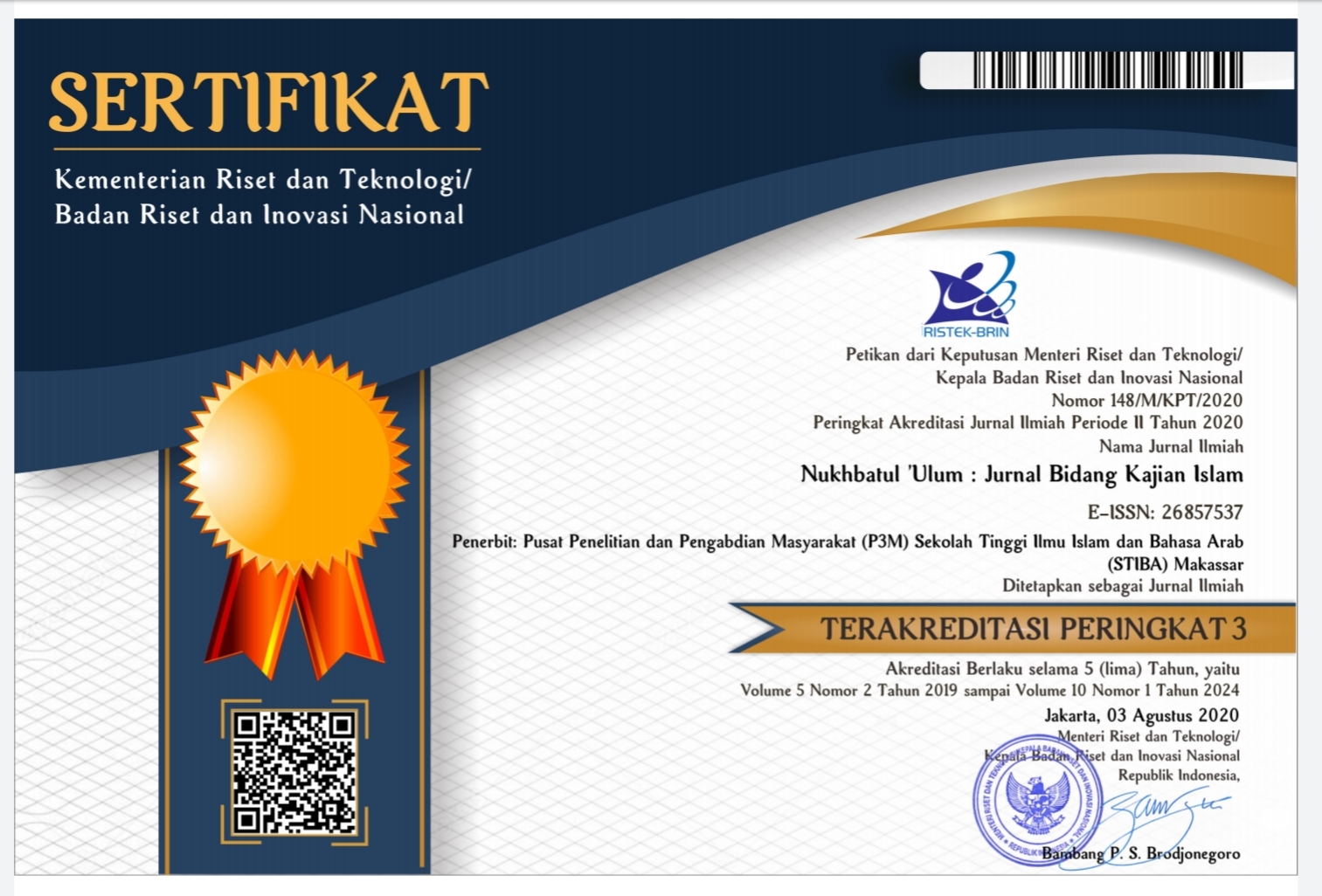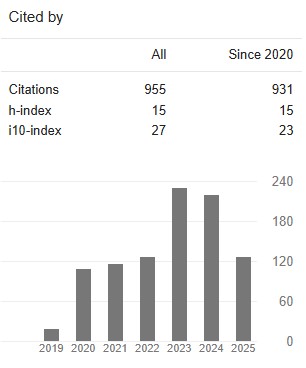Konsep Penetapan Had dan Kafarat dengan Kias (Studi Komparasi Pendapat Imam Syāfiʻī dan Imam Abū Ḥanīfah)
The Concepts of Determining Had and Kafarat with Qiyas (Comparation Study of the Opinion of Imam Syāfiʻī and Imam Abū Ḥanīfah)
DOI:
https://doi.org/10.36701/nukhbah.v9i2.1129Keywords:
Kafarat, Had, Qiyas, Imam Syāfiʻī, Imam Abū ḤanīfahAbstract
This research aims to find out the opinions of Imam Syāfi'i and Imam Abū Ḥanīfah regarding the determination of had and kafarat with the problem that the researcher raises in this research, namely; first, what do Imam Syāfiʻī and Imam Abū Ḥanīfah think about determining had and kafarat with kias; and second, what is the comparative analysis of the opinions of Imam Syāfiʻī and Imam Abū Ḥanīfah regarding the determination of had and kafarat with kias. This research includes library research using a normative approach and a comparative approach. The research results show that; Firstly, Imam Syāfiʻī allows the use of kias in determining had and kafarat with the terms of rukun and kias conditions being in the determination of kias. Meanwhile, Imam Abū Ḥanīfah rejects the idea of determining had and kafarat because had was established to prevent people from being afraid of committing immoral acts and kafarat was established to abort sins. The level of punishment is only Allah SWT. who knows, no allusions are allowed. Second, the similarity of opinion between Imam Syāfiʻī and Imam Abū Ḥanīfah is the use of figures of speech as legal istinbat. The difference is that Imam Abū Ḥanīfah does not use kias in matters of had and kafarat except for the crime of takzir, while Imam Syāfiʻī considers it valid to use kias in the aspect of jinayat. After reading and studying several propositions and opinions of Imam Syāfiʻī and Imam Abū Ḥanīfah, the researcher is more inclined to strengthen Imam Syāfiʻī's opinion because some of the arguments which say that the use of kias in determining had and kafarat are not permissible are weak. Meanwhile, Imam Syāfiʻī's opinion which allows kias in the determination of had and kafarat is strengthened by the argument of the words of the Prophet Muhammad. when sending Mu'āż bin Jabal to Yemen.
Downloads
References
Al-Qur’an dan Terjemah.
Abu Dāud. Sunan Abī Dāud ma’a Syarh ‘Aunu al-Ma’Būd, Juz 3. India: Al-Maṭba’ah al-Anṣāriyah, t.th.
Abu Jayb, Sa’dī. Al-Qamūs al-Fiqhī Lugatan wa Iṣṭilāhan. Cet.II; Suriah: Dār al-Fikr, 1998.
Abu Zahrah, Muhammad. Uṣūl al-Fiqh. Kairo: Dār al-Fikr al-‘Arabī, t.th.
_______. Abū Ḥanīfah Ḥayātuhu wa ‘Aṣruhu Ārāuhu wa Fiqhuhu. Cet. II: Qāhirah: Dār al-Fikr al-ʻArabī, t.th.
’Audah, Abd al-Qādir. Al-Tasyri’ al-Jināī al-Islāmī, Juz 1. Kairo: Dār Ḥadīṡ, 2009.
Al-Anṣārī, Ibn Manẓūr. Lisān al-‘Arab. Cet. III; Beirut: Dār Ṣādr, 1414H.
Al-Baihaqī, Abū Bakr Aḥmad bin Ḥusain bin ‘Alī. Al-Sunan Al-Baihaqī, Juz 8. Beirut: Dār al-Kutub al-Ilmiyah, 2003.
Al-Dabbusī, Abū Zaid ‘Ubaidillah bin ‘Umar bin ‘Īsā. Taqwīmu al-Adillah fī Uṣūl Al-Fiqh. Cet. I; Beirut: Dār al-Kutub al-Ilmiyah, 2001.
Al-Darini, Fatḥi. Al-Manāhij al-Uṣūliyyah fī al-Ijtihād wa bi al-Ra’yi al-Tasyrī’ al-Islāmī. Cet. I; Damaskus: Dār al-Kutub al-Ḥadīṡ, t.th.
Al-Ḥanafī, Ibn al-Humām. Fatḥu al-Qadīr ‘alā al-Hidāyah. Cet. I; Libanon: Dār al-Fikr, 1970.
Al-Ḥanbalī, Syahāb al-Dīn Aḥmad al-‘Uskurī. Al-Minhaj al-Ṣaḥīh fī al-Jam’i Bayna ma fī al-Muqni’i wa al-Tanqīḥ, Juz 2. Kuwait: Dār Asfār, 2016.
Al-Iftā’, Wahdah al-Bahṡ al-‘Ilmī bi Idārah. Al-Mażāhib al-Fiqhiyyah al-Arbaʻah. Cet. I; t.t.p: Idārah al-Iftā’,t.th.
Al-Jazairī, Abdurraḥmān bin Muḥammad ‘Auḍ. Al-Fiqh ‘alā al-Mazāhib al-Arba’Ah. Cet. II; Beirut: Dār al-Kutub al-‘Ilmiyah, t.th.
Al-Juzairī, Abdurraḥmān. Al-Fiqh ʻalā al-Mażāhib al-Arbaʻah, Juz 5. Beirut: Dār al-Kutub al-ʻIlmiyah, t.th.
Al-Kasānī, Abū Bakr bin Mas’ūd. Badā’i al-Ṣanā’i fī Tartībi al-Syarā’i. Cet. I; Mesir: Dār al-Kutub al-‘Alamiyah, t.th.
Al-Māliki, Muḥammad bin ‘Alawi. Al-Qawā’id al-Asāsiyah fī Uṣūl al-Fiqh. Cet. I; Jeddah: Maktabah al-Mulk, t.th.
Al-Namlah, ‘Abd al-Karīm bin ‘Alī bin Muḥammad. Al-Muhażżab fī ‘Ilmi Uṣūl al-Fiqh al-Muqārani, Juz 4. Riyāḍ: Maktabah al-Rusyd, t.th.
Al-Samarqandi, Abū Bakr Muḥammad bin Aḥmad. Mīzān al-Uṣūl fī Natāij al-‘Uqūl. Cet. I; Qatar: Maṭābi’ al-Dauḥah al-Ḥadīṡah, t.th.
Al-Syāmī,' Abd al-Raqīb Ṣāliḥ Muḥsin. Al-Kaffārātu Aḥkāmun wa Ḍawābiṭun, Cet. I: t.tp.: t.p., 1429H/2018M.
Al-Sarkhasī, Abū Bakr Muḥammad bin Ażmad bin Abī Sahl. Uṣūl al-Sarkhasī. Juz 1; Beirut: Beirut: Dār al-Ma’rifah, t.th.
Al-Ṣiddiqī, Muhammad Hasby. Pokok-Pokok Pegangan Imam Mazhab, Juz 2. Semarang: Pustaka Rizky Putra, t.th.
Al-Syāfiʻī, Abū ‘Abdillah Muḥammad bin Idris. Al-Risālah. Cet. I; Mesir: Muṣṭafā al-Bābī al-Ḥalabī, 1928M.
———. Al-Um, Juz 2. Beirut: Dār al-Ma’rifah, 1410H/1990M.
Al-Syaukānī, Muḥammad bin ‘Alī bin Muḥammad bin ‘Abdillah. Irsyād al-Fuḥū Ilā Taḥqīq al-Ḥaq min ‘Ilmi al-Uṣūl, Juz 2. (t.tp.: Dār al-Kitāb al-‘Arabī, 1999.
Al-Syīrāzī, Abū Isḥāq Ibrāhīm bin ‘Alī ibn Yūsūf. Al-Tabṣirah fī Uṣūl al-Fiqh. Cet. I; Damaskus: Dār al-Fikr, t.th.
Al-Zuḥailī, Wahbah. Uṣūl al-Fiqh al-Islāmī. Damaskus: Dār al-Fikr, 2006.
Ali, Hapid. ‘Studi Analisis Metode Instinbat Hukum Imam Syafi’i dan Imam Hanafi Tentang Ba’i Al-Mu’athoh’, Jurnal Perspektif, 5.1 (2021): h. 43
Chalil, Moenawir. Biografi Empat Serangkai Imam Mazhab. Cet. IX; Jakarta: PT. Bulan Bintang, t.th.
Dimas, Tariq Suwaidan penerjemah: M. Taufik. Al-Hanafiyah al-Nu’man, ed. by M. Taufik Dimas. Jakarta: Zaman, 2013.
Fuad, Ahmad Masfuful. ‘Kias Sebagai Salah Satu Metode Istinbat al-Hukm’, Mazhahib, 15.1 (2016)
Hawī, Aḥmad Sa’id. Al-Muḍal Ilā Mazhab Abī Ḥanīfah. Andalus: Dār al-Andalus al-Hudrā linaṣri wa al-Tawzī’, 2002.
Henfi. ‘Hukuman Had Bagi Peminum Khamar Perspektif Hanafiyah dan Syafiʻiyah (Studi Analisis Komparatif). Skripsi. .Makassar: Prodi Perbandingan Mazhab STIBA, 2022.
Kasdi, Abdurrahman. ‘Metode Ijtihad dan Karakteristik Fiqih Abu Hanifah’, Yudisia, 5.2 (2014): h. 223
Kementerian Agama Republik Indonesia, Al-Qur’an dan Terjemah. Jakarta: Ummul Qura, 2017.
Qardawī, Yusuf. Fikih Perbedaan Pendapat Antar Gerakan Islam. Cet. IV; Jakarta: Rabbani Press, 2002.
Sābiq, Sayyid. Fiqh al-Sunah, Juz 2. Beirut: Dār al-Kitāb al-‘Arabī, t.th.
Sumardi, Didi dan Wawan Kurniawan. “Sanksi Pelaku Jarimah Homoseks Menurut Anas Ibn Malik”’, Varia Hukum, 1.1 (2019): h.13
Yanggo, Huzaimah Tahido. Masāil Fiqhiyah. Bandung: Angkasa, 2005.
______. Pengantar Perbandingan Mazhab, Cet. I; Jakarta: Logos Wacana Ilmu, t.th.
Zaidah, Ṣāliḥ. Ḥujjah al-Qiyās. Cet. I: Kairo: Dār al-Ṣalwah, 1987.
Zainal, Eldin. Hukum Pidana Islam Sebuah Perbandingan (Al-Muqarranah al- Mażāhib fī al-Jināyah). Ba


















